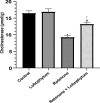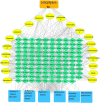Unveiling Lobophytum sp. the neuroprotective potential of Parkinson's disease through multifaceted mechanisms, supported by metabolomic analysis and network pharmacology
- PMID: 39294162
- PMCID: PMC11411073
- DOI: 10.1038/s41598-024-66781-9
Unveiling Lobophytum sp. the neuroprotective potential of Parkinson's disease through multifaceted mechanisms, supported by metabolomic analysis and network pharmacology
Abstract
A main feature of neurodegenerative diseases is the loss of neurons. One of the most prevalent neurodegenerative illnesses is Parkinson disease (PD). Although several medications are already approved to treat neurodegenerative disorders, most of them only address associated symptoms. The main aim of the current study was to examine the neuroprotective efficacy and underlying mechanism of Lobophytum sp. crude extract in a rotenone-induced rat model of neurodegeneration mimicking PD in humans. The influence of the treatment on antioxidant, inflammatory, and apoptotic markers was assessed in addition to the investigation of TH (tyrosine hydroxylase) immunochemistry, histopathological changes, and α-synuclein. Metabolomic profiling of Lobophytum sp. crude extract was done by using High-Resolution Liquid Chromatography coupled with Mass Spectrometry (HR-LC-ESI-MS), which revealed the presence of 20 compounds (1-20) belonging to several classes of secondary metabolites including diterpenoids, sesquiterpenoids, steroids, and steroid glycosides. From our experimental results, we report that Lobophytum sp. extract conferred neuroprotection against rotenone-induced PD by inhibiting ROS formation, apoptosis, and inflammatory mediators including IL-6, IL-1β, and TNF-α, NF-кB, and subsequent neurodegeneration as evidenced by decreased α-synuclein deposition and enhanced tyrosine hydroxylase immunoreactivity. Moreover, a computational network pharmacology study was performed for the dereplicated compounds from Lobophytum sp. using PubChem, SwissTarget Prediction, STRING, DisGeNET, and ShinyGO databases. Among the studied genes, CYP19A1 was the top gene related to Parkinson's disease. Dendrinolide compounds annotated a high number of parkinsonism genes. The vascular endothelial growth factor (VEGF) pathway was the top signaling pathway related to the studied genes. Therefore, we speculate that Lobophytum sp. extract, owing to its pleiotropic mechanisms, could be further developed as a possible therapeutic drug for treating Parkinson's disease.
Keywords: Lobophytum sp.; Network pharmacology; Neurodegenerative diseases; Parkinson's disease; Rotenone (ROT); VEGF pathway.
© 2024. The Author(s).
Conflict of interest statement
The authors declare no competing interests.
Figures















Similar articles
-
Unlocking the potential of edible Ulva sp. seaweeds: Metabolomic profiling, neuroprotective mechanisms, and implications for Parkinson's disease management.Arch Pharm (Weinheim). 2024 Nov;357(11):e2400418. doi: 10.1002/ardp.202400418. Epub 2024 Jul 31. Arch Pharm (Weinheim). 2024. PMID: 39086040
-
The potential neuroprotective effect of diosmin in rotenone-induced model of Parkinson's disease in rats.Eur J Pharmacol. 2022 Jan 5;914:174573. doi: 10.1016/j.ejphar.2021.174573. Epub 2021 Oct 14. Eur J Pharmacol. 2022. PMID: 34656609
-
Acteoside exerts neuroprotection effects in the model of Parkinson's disease via inducing autophagy: Network pharmacology and experimental study.Eur J Pharmacol. 2021 Jul 15;903:174136. doi: 10.1016/j.ejphar.2021.174136. Epub 2021 Apr 30. Eur J Pharmacol. 2021. PMID: 33940032
-
Neuroprotective role of kolaviron in striatal redo-inflammation associated with rotenone model of Parkinson's disease.Neurotoxicology. 2019 Jul;73:132-141. doi: 10.1016/j.neuro.2019.03.005. Epub 2019 Mar 28. Neurotoxicology. 2019. PMID: 30930291
-
Importance of glucose and its metabolism in neurodegenerative disorder, as well as the combination of multiple therapeutic strategies targeting α-synuclein and neuroprotection in the treatment of Parkinson's disease.Rev Neurol (Paris). 2024 Oct;180(8):736-753. doi: 10.1016/j.neurol.2023.08.011. Epub 2023 Nov 30. Rev Neurol (Paris). 2024. PMID: 38040547 Review.
Cited by
-
Clinical implications of Alu-based cell-free DNA and serum onco-piRNA monitoring in colorectal cancer management.Clin Transl Oncol. 2025 Aug;27(8):3449-3457. doi: 10.1007/s12094-025-03863-8. Epub 2025 Feb 19. Clin Transl Oncol. 2025. PMID: 39969763
-
Vincamine induces cytoprotective autophagy via regulation of ampk/mtor signaling pathway in gentamicin-induced hepatotoxicity and nephrotoxicity in rats.Sci Rep. 2025 Jun 20;15(1):20202. doi: 10.1038/s41598-025-06355-5. Sci Rep. 2025. PMID: 40542078 Free PMC article.
-
Exploration of the antitumor effect and mechanism of gambogic acid on osteosarcoma through network pharmacology and experimental pharmacology study.Sci Rep. 2025 Jul 1;15(1):21647. doi: 10.1038/s41598-025-05308-2. Sci Rep. 2025. PMID: 40594358 Free PMC article.
References
-
- Marras, C. et al. Dihydropyridine calcium channel blockers and the progression of parkinsonism. Ann. Neurol.71(3), 362–369 (2012). - PubMed
-
- Roy, S. P. et al. Antiparkinsonian activity of Tabebuia impetiginosa bark and biochemical analysis of dopamine in rat brain homogenates. In Annales Pharmaceutiques Françaises. (Elsevier, 2022). - PubMed
-
- Yahr, M. D. et al. Treatment of parkinsonism with levodopa. Arch. Neurol.21(4), 343–354 (1969). - PubMed
MeSH terms
Substances
LinkOut - more resources
Full Text Sources
Medical

